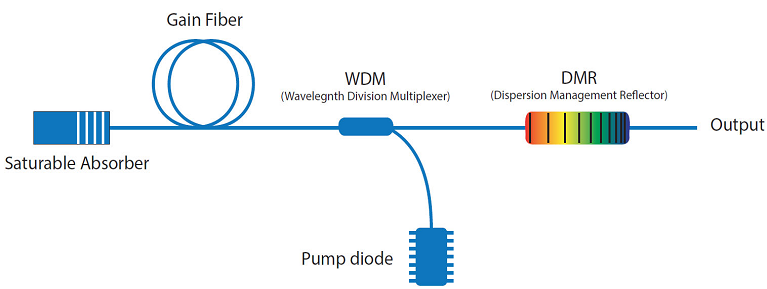Dispersion Management in Ultrafast Mode-locked Fiber Oscillator using Chirped Fiber Bragg Grating
On: Apr 19, 2023
In: Ultrafast Lasers
Fiber lasers producing ultrashort pulses (also known as ultrafast fiber lasers) offer many advantages over their solid-state counterpart, driving their increasing adoption in a wide range of industrial, biomedical and scientific applications. Most ultrafast laser systems are based on passive mode-locked oscillators, often relying on a saturable absorber that has low loss for high intensities and high loss for low intensities. Different physical phenomena usually occur in the cavity, including dispersive and nonlinear effects.
Dispersive effects refer to the different speeds at which different wavelengths of light travel through a medium (chromatic dispersion). This leads to an increase in the duration of the pulses during propagation in the optical chain, reducing the peak power of the pulses at the output of the system. In ultrafast fiber-based systems the amount of dispersion induced by the optical fiber is nonnegligible. Nonlinear effects, on the other hand, refer to changes in the properties of the propagating light pulses due to their high intensity. In ultrafast fiber lasers, the most common nonlinear effect is self-phase modulation (SPM), which causes spectral broadening and phase distortion.
The interplay between dispersive, nonlinear, and other physical effects must be properly managed in mode-locked fiber oscillators to ensure stable and efficient operation. The integration of a Dispersion Management Reflector (DMR) in the laser cavity is a widely used approach to balance these phenomena. The DMR is a Chirped Fiber Bragg Grating (CFBG) with tailored dispersion and reflectivity, acting as the output coupler of the cavity.

Figure 1. Illustration of a Mode-Locked oscillator with a typical DMR.
The DMR provides precise compensation for either anomalous or normal dispersion for mode-locked ultrafast lasers, with especially high dispersion accuracy and customizable wavelengths to match the cavity lengths. Key attributes are:
- High reflectivity, which helps to increase the efficiency of the laser cavity, enabling the generation of ultrashort pulses with higher peak powers.
- Tailoring of spectral bandwidth and dispersion rate over three orders of magnitude to accommodate laser designs in the picosecond and femtosecond domains.
- Very robust design inherently eliminating misalignment caused by temperature changes or mechanical shocks.
- Cost-effectiveness and ease of integration, making DMR an industry-leading component for mass production of ultrafast fiber lasers.
Conclusion
Overall, the benefits of the DMR make it a powerful component for optimizing the performance of mode-locked fiber oscillators. By providing high reflectivity, customizable bandwidth and dispersion rate in a rugged and cost-effective package, DMR enables the generation of high-quality ultrashort pulses with high peak powers, making them ideal for a wide range of ultrafast applications.
